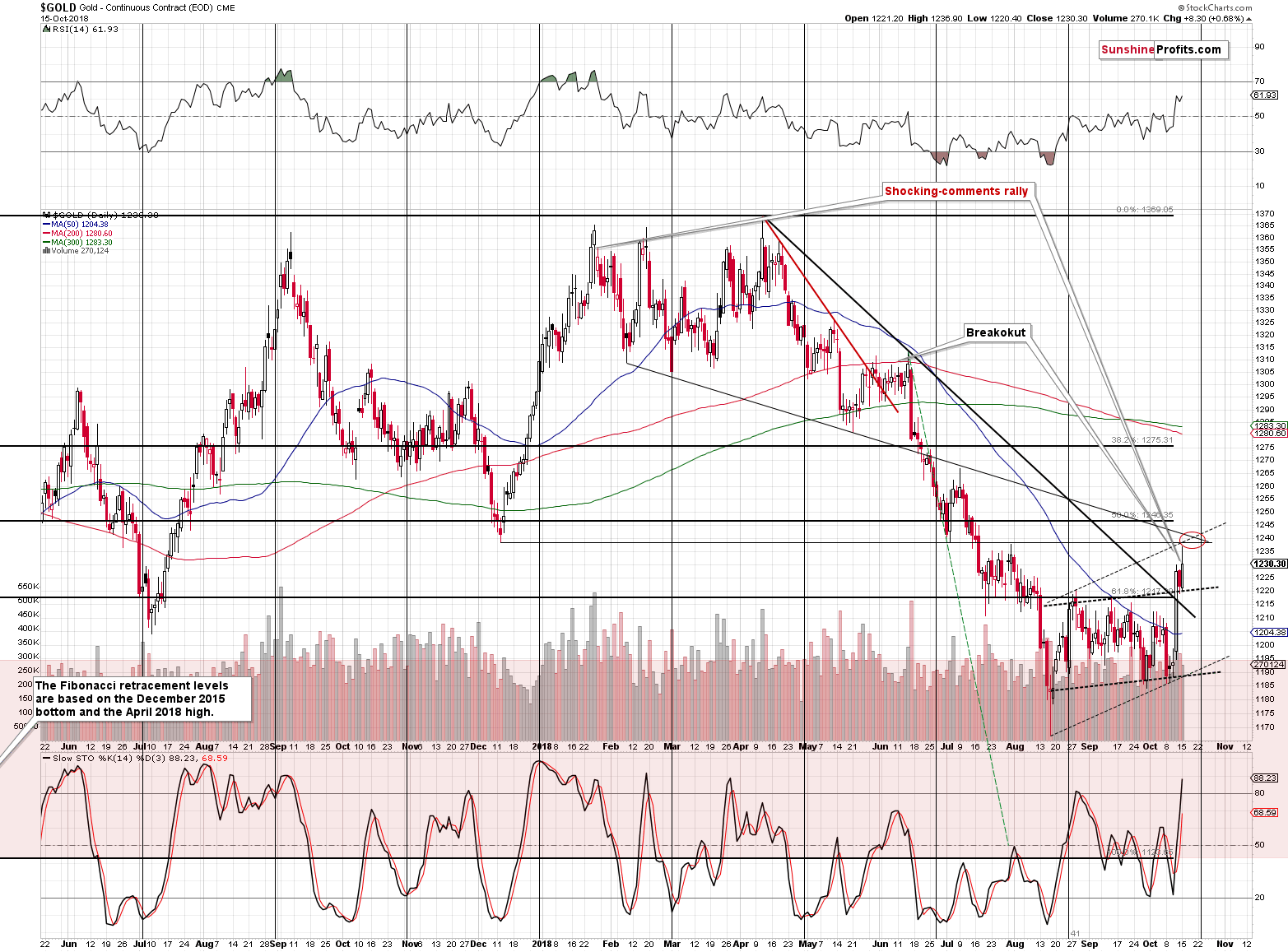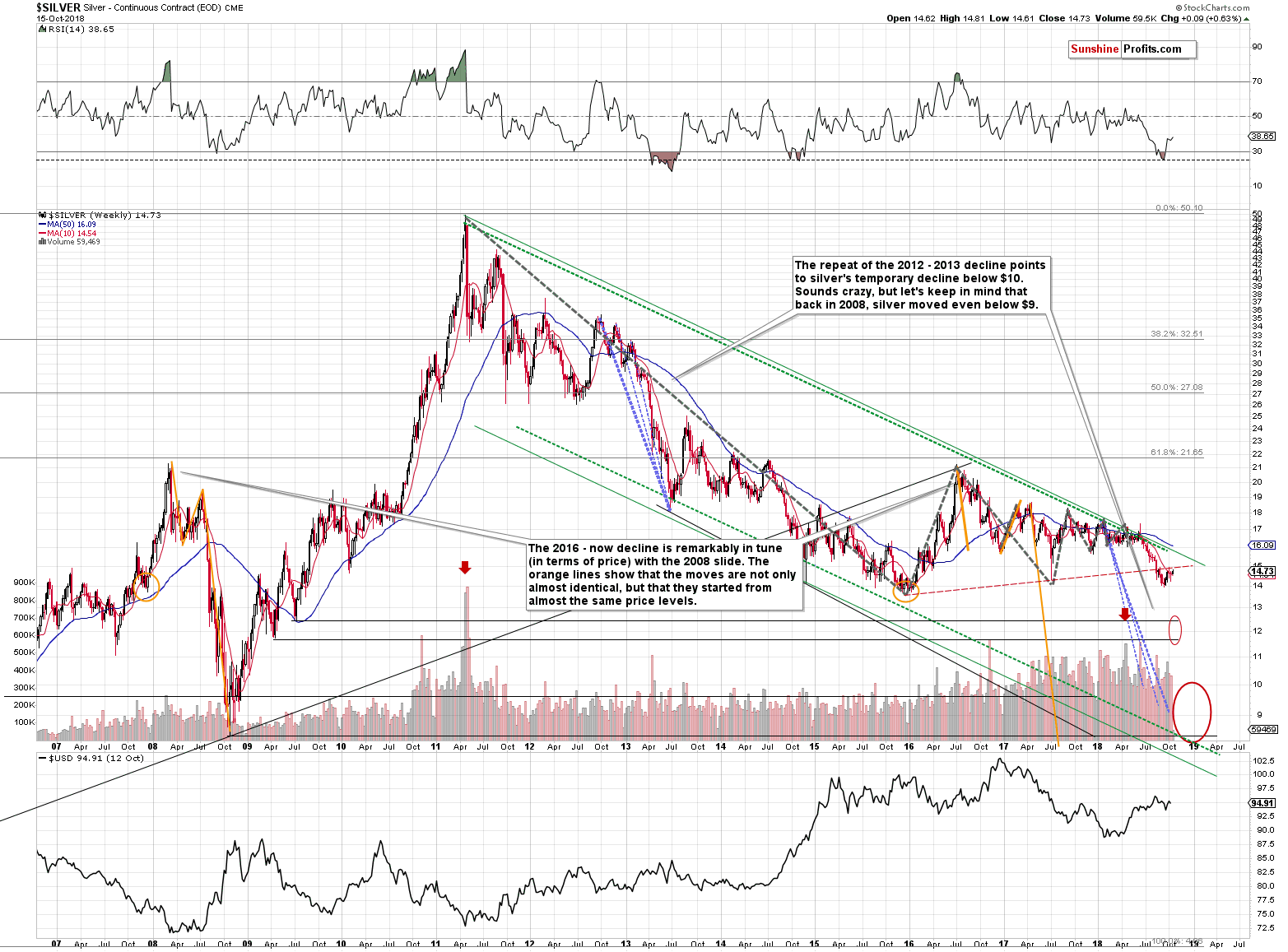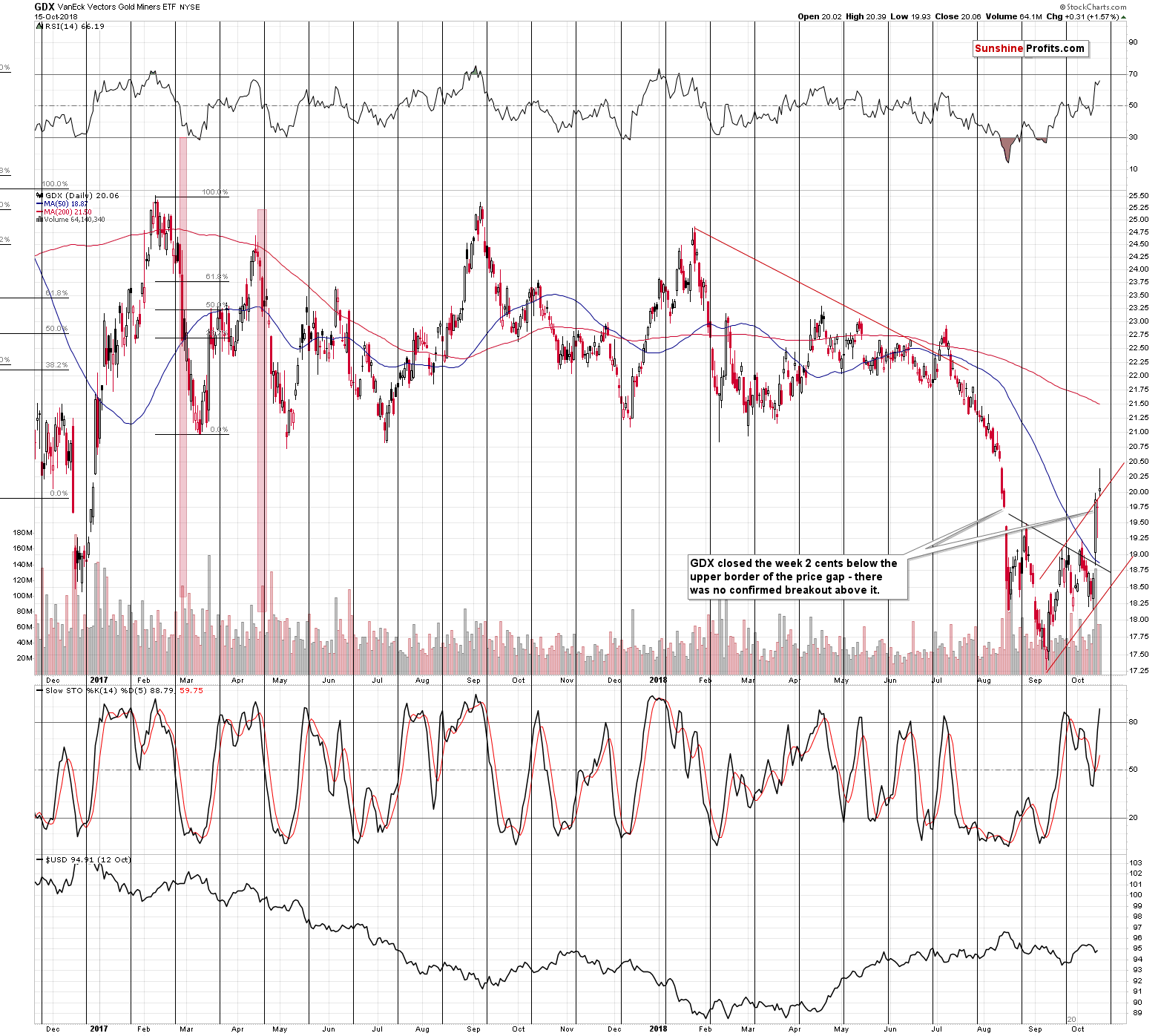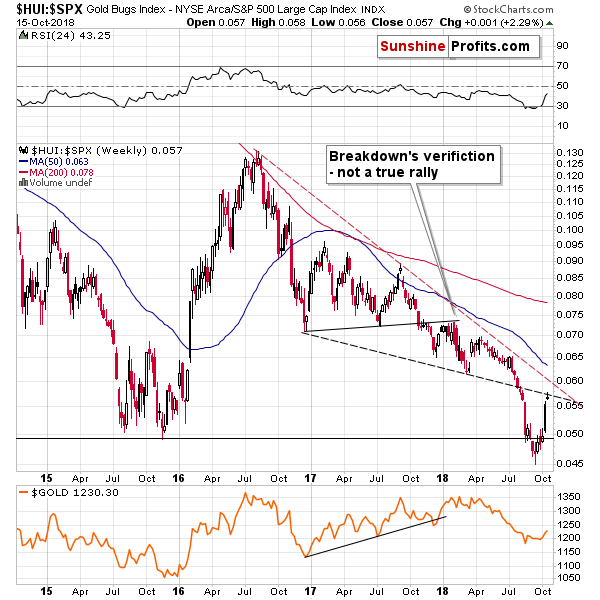Briefly: in our opinion, full (200% of the regular size of the position) speculative short positions in gold, silver and mining stocks are justified from the risk/reward perspective at the moment of publishing this alert.
Gold, silver, and mining stocks rallied yesterday, but they gave back a portion of their daily gains before the end of the session. The reversal was particularly visible in mining stocks. Was that a top or just a post-breakout pause?
Let’s start with gold, and in particular by quoting what we wrote about it yesterday.
Gold: Price Moves vs. Changes
Gold moved lower on Friday, but it didn’t invalidate the previous breakout in terms of daily or weekly closing prices, so it was confirmed. The implications are bullish for the short term. The likely upside target is now close to the $1,240 level. This level is created by the December 2017 bottom ($1,238.30), the early July 2018 bottom and the late July 2018 high.
Now, today’s pre-market high for gold’s futures (as reported by finance.yahoo.com) was $1,236.90. That’s just $1.40 below the December 2017 bottom. Consequently, it seems quite likely that the bullish action that was likely to happen based on the previous breakout, has already happened.
Moving back to the context that we quoted above, please note that after the shocking January 2018 comments gold continued to move higher in a specific way. It first soared, then corrected and then rallied once again. You can see this correction on an intraday basis in the candlestick that marked the exact top – price moved lower first and rallied shortly thereafter. It’s not 100% like that in this case as gold closed lower on Friday, but taking intraday action into account (including what happened in today’s pre-market trading) we see that the action is indeed very similar. Based on both of the above factors: gold being just below the short-term upside target and based on the link to the previous post-shocking-comments performance, it seems that the top is already in, or that it is extremely close.
The above-mentioned pre-market high was really the final high for the day. Gold moved lower after we wrote the above and ended the session at $1,230. Since the target was so close, it’s highly likely that the short-term top is already in.
The Silver Breakdown
Silver moved higher by 9 cents, but it didn’t invalidate the previous breakdown below the rising red support line, which has now turned into resistance. Consequently, nothing changed, and the outlook remains bearish.
Having said the above, let’s take a look at the mining stocks.
Miners’ Reversal
The reversal in the mining stocks was even more profound than the one in gold, and it’s a very bearish sign for the short term.
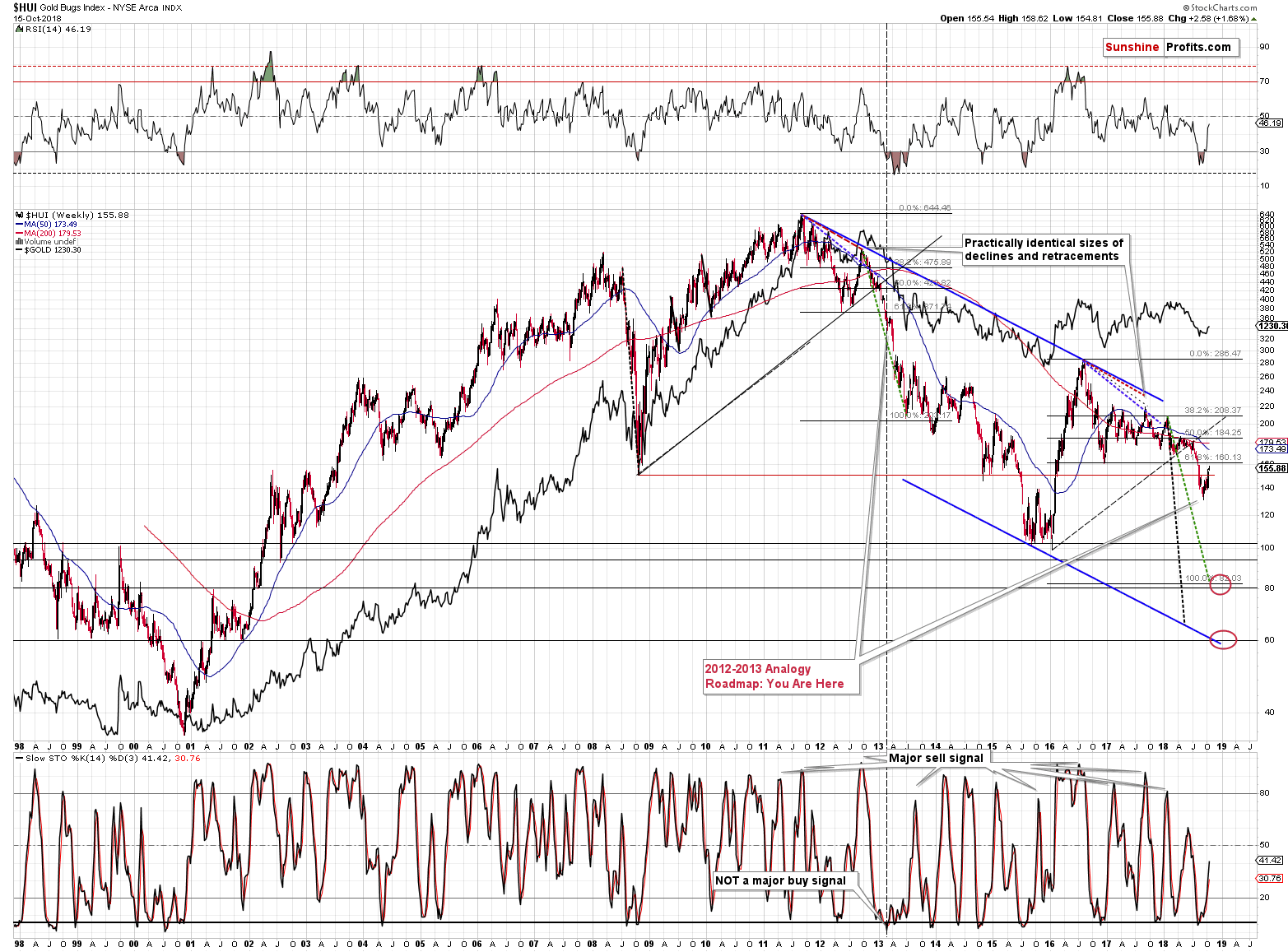
From the long-term point of view, we see that the gold miners have not moved above the 2016 lows, which means that the current situation remains similar to what we saw in April 2013 before the decline. Back then the corrective upswing was smaller, but it also took miners higher, yet not to the previous major bottom, let alone above it.
Based on yesterday’s reversal, it seems that the next short-term move will be lower. This, in turn, means that that the link to 2013 is likely to be preserved and the very bearish implications for the following weeks will remain in place.
When looking at miners’ performance relative to the general stock market we also see bearish indications from both: short- and long-term point of view:
Gold Stocks vs. Other Stocks
From the long-term point of view, we see that the ratio between gold stocks and other stocks (S&P 500) moved to the declining resistance line, which is a good reason for a reversal.
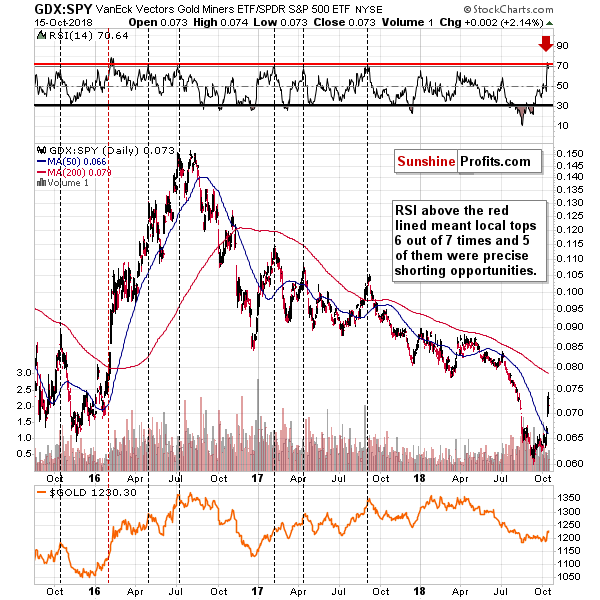
On the short-term chart, we see that the rally was so sharp that it triggered one of the most reliable sell signs (6 out of 7 signals in the past few years were followed by substantially lower gold prices). The sell sign is flashed when the RSI based on the ratio moves visibly above the level of 70. That’s what we just saw.
Questions
We received a couple of interesting questions and it seems that our replies might be useful also to you.
One of the questions was if the current decline in the stock market is going to be as significant as it was in 2008 and if it’s going to drag gold lower as it did in 2008. In our view, it’s possible, but not very likely. Back in 2008, there was a liquidity crisis and practically all assets declined due to it. The situation is not similar to what happened then – there is no liquidity crisis. But, gold is likely to decline in the following weeks anyway due to other reasons and the current spike in stock market’s volatility is one of the bearish confirmations. In other words, things don’t have to be as bad for the stock market for gold to decline. In fact, they don’t have to be bad at all for gold to decline, but the VIX signal that we discussed in the previous alerts makes a decline more likely.
Another question was about the situation in the CoT reports and if it’s likely to trigger a rally here. We already commented on these reports usefulness in the past and nothing changed in that regard, so instead of replying once again, we will invite you to read our previous analysis of CoT’s usefulness and problems related to it.
There was also a question about the possibility of seeing an inverse head-and-shoulders in gold in a long-term basis. It’s one of the boomerang questions that we get asked on regular basis (the same goes for the CoT questions). Just like the CoT question, it was already replied to earlier. You can read the full analysis here, but the long-story-short version is that the pattern is very far from being completed and as such has no implications at this time. It simply doesn’t exist.
We were asked if gold is starting a major rally due to the trade wars, and other fundamental factors. And our reply is that despite the very short-term price moves, the fundamentals are unlikely to determine the market’s short-term and – to some extent – medium-term trend. They can tell that the market is going to rally in the following years (!), but they don’t say much about the next few months. Are fundamentals positive? We agree – it means that gold can soar in the coming years, and it can just as well rally and decline in the next few months. The technical, cyclical and other analogous factors can be applied to determine where a given market (here: gold) is likely to move in the next several weeks and months. Fundamental details are not likely to indicated the above.
Finally, we were asked if the current reading (26.67)in the Gold Miners’ Bullish Percent Index is a bullish factor. It’s not.
As a reminder, the Gold Miners Bullish Percent Index ($BPGDM) is a gauge of overbought and oversold conditions for the gold mining sector. It is a breadth indicator based on the number of stocks with Point & Figure buy signals (a Point & Figure chart emphasizes strong moves while ignoring small ones) within this index. You can see the last several years of its performance below.

To be precise, the current reading is more or less in the middle (median) of the trading range. The only exception that we saw was in the first half of 2016. The index moved a bit higher recently, but it didn’t start the rally from very oversold levels. The current move so far seems similar to what we saw in October and November 2016, before the sizable decline and in the final part of the corrective upswing. Is any of the above bullish? Not really.
Yes, the index is closer to being oversold than to being overbought, but that’s not an indication of a bottom. In fact, in 2013 when we saw similar values of the Gold Miners Bullish Percent Index, we the real decline was only starting. Given the similarities to what happened 5.5 years ago, should the current value of the index be viewed as something bullish or an indication that the bottom is in? Definitely not. Some may even say that it’s a bearish indication, because the true bottom was so much lower in 2013. In fact, the final bottom was not even in, when the index moved to 0 for the first time. Consequently, if this is THE final decline in the precious metals sector, it might be best to view the Gold Miners Bullish Percent Index and it’s 0 reading as a “bottom is near” sign instead of viewing it as a sign that says “the bottom is definitely in”.
Important Analyses
Before summarizing, we would like to emphasize that we have recently posted several analyses that are very important and that one should keep in mind, especially in the next several weeks. If you haven’t had the chance of reading them previously, we encourage you to do so today:
- Dear Gold Investor - Letters from 2013 - Analogy to 2013, which should make it easier to trade the upcoming sizable upswing (if enough factors point to it, that is) and to enter the market close to the final bottom.
- Gold to Soar Above $6,000 - discussion of gold’s long-term upside target of $6,000.
- Preparing for THE Bottom in Gold: Part 6 – What to Buy - extremely important analysis of the portfolio structure for the next huge, multi-year rally in the precious metals.
- Preparing for THE Bottom in Gold: Part 7 – Buy-and-hold on Steroids - description of a strategy dedicated to significantly boosting one’s long-term investment returns while staying invested in the PM sector.
- Gold’s Downside Target, Upcoming Rebound, and Miners’ Buy Plan - details regarding the shape of the following price moves, a buying plan for mining stocks, and a brief discussion of the final price targets for the current decline.
- Gold: What Happened vs. What Changed - discussion of the latest extreme readings from gold’s CoT report
- Key Factors for Gold & Silver Investors - discussion of key, long-term factors that support the bearish outlook for PMs. We are often asked what makes us so bearish – this article is a reply to this question.
- The Upcoming Silver Surprise - two sets of price targets for gold, silver and mining stocks: the initial and the final one.
- Precious Metals Sector: It’s 2013 All Over Again - comparison between 2013 and 2018 throughout the precious metals sector, the general stock market and the USD Index. Multiple similarities point to the repeat of a 2013-style volatile decline in the PMs.
- Changing One's Mind - Why, When, and How – discussing the way of analyzing the market that helps to stay focused on the growing one’s capital while not being influenced by the loss aversion bias. This essay might be particularly useful in light of the recent upswing in the PMs.
Summary
Summing up, the breakout in gold is a bullish development for the short term, but the rally that was likely to be seen based on it, could have already taken place. This is especially the case given the shape of yesterday’s session in mining stocks – a clear reversal. All in all, it seems that the huge profits on our short positions will soon become enormous, even if it takes a few more days before that happens.
As always, we’ll keep you – our subscribers – informed.
To summarize:
Trading capital (supplementary part of the portfolio; our opinion): Full short positions (200% of the full position) in gold, silver and mining stocks are justified from the risk/reward perspective with the following stop-loss orders and exit profit-take price levels:
- Gold: profit-take exit price: $1,062; stop-loss: $1,253; initial target price for the DGLD ETN: $82.96; stop-loss for the DGLD ETN $49.47
- Silver: profit-take exit price: $12.72; stop-loss: $15.76; initial target price for the DSLV ETN: $46.97; stop-loss for the DSLV ETN $27.37
- Mining stocks (price levels for the GDX ETF): profit-take exit price: $13.12; stop-loss: $20.83; initial target price for the DUST ETF: $80.97; stop-loss for the DUST ETF $27.67
Note: the above is a specific preparation for a possible sudden price drop, it does not reflect the most likely outcome. You will find a more detailed explanation in our August 1 Alert. In case one wants to bet on junior mining stocks’ prices (we do not suggest doing so – we think senior mining stocks are more predictable in the case of short-term trades – if one wants to do it anyway, we provide the details), here are the stop-loss details and target prices:
- GDXJ ETF: profit-take exit price: $17.52; stop-loss: $31.23
- JDST ETF: initial target price: $154.97 stop-loss: $51.78
Long-term capital (core part of the portfolio; our opinion): No positions (in other words: cash)
Insurance capital (core part of the portfolio; our opinion): Full position
Important Details for New Subscribers
Whether you already subscribed or not, we encourage you to find out how to make the most of our alerts and read our replies to the most common alert-and-gold-trading-related-questions.
Please note that the in the trading section we describe the situation for the day that the alert is posted. In other words, it we are writing about a speculative position, it means that it is up-to-date on the day it was posted. We are also featuring the initial target prices, so that you can decide whether keeping a position on a given day is something that is in tune with your approach (some moves are too small for medium-term traders and some might appear too big for day-traders).
Plus, you might want to read why our stop-loss orders are usually relatively far from the current price.
Please note that a full position doesn’t mean using all of the capital for a given trade. You will find details on our thoughts on gold portfolio structuring in the Key Insights section on our website.
As a reminder – “initial target price” means exactly that – an “initial” one, it’s not a price level at which we suggest closing positions. If this becomes the case (like it did in the previous trade) we will refer to these levels as levels of exit orders (exactly as we’ve done previously). Stop-loss levels, however, are naturally not “initial”, but something that, in our opinion, might be entered as an order.
Since it is impossible to synchronize target prices and stop-loss levels for all the ETFs and ETNs with the main markets that we provide these levels for (gold, silver and mining stocks – the GDX ETF), the stop-loss levels and target prices for other ETNs and ETF (among other: UGLD, DGLD, USLV, DSLV, NUGT, DUST, JNUG, JDST) are provided as supplementary, and not as “final”. This means that if a stop-loss or a target level is reached for any of the “additional instruments” (DGLD for instance), but not for the “main instrument” (gold in this case), we will view positions in both gold and DGLD as still open and the stop-loss for DGLD would have to be moved lower. On the other hand, if gold moves to a stop-loss level but DGLD doesn’t, then we will view both positions (in gold and DGLD) as closed. In other words, since it’s not possible to be 100% certain that each related instrument moves to a given level when the underlying instrument does, we can’t provide levels that would be binding. The levels that we do provide are our best estimate of the levels that will correspond to the levels in the underlying assets, but it will be the underlying assets that one will need to focus on regarding the signs pointing to closing a given position or keeping it open. We might adjust the levels in the “additional instruments” without adjusting the levels in the “main instruments”, which will simply mean that we have improved our estimation of these levels, not that we changed our outlook on the markets. We are already working on a tool that would update these levels on a daily basis for the most popular ETFs, ETNs and individual mining stocks.
Our preferred ways to invest in and to trade gold along with the reasoning can be found in the how to buy gold section. Additionally, our preferred ETFs and ETNs can be found in our Gold & Silver ETF Ranking.
As a reminder, Gold & Silver Trading Alerts are posted before or on each trading day (we usually post them before the opening bell, but we don't promise doing that each day). If there's anything urgent, we will send you an additional small alert before posting the main one.
=====
Latest Free Trading Alerts:
SPX continued losses. CPI slowed down. IMF cut its projection of global growth. What does it all imply for the gold market?
Does Gold Like Acronyms? The Golden Story of SPX, CPI, and IMF
=====
Thank you.
Sincerely,
Przemyslaw Radomski, CFA
Founder, Editor-in-chief, Gold & Silver Fund Manager
Gold & Silver Trading Alerts
Forex Trading Alerts
Oil Investment Updates
Oil Trading Alerts


